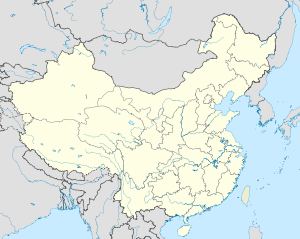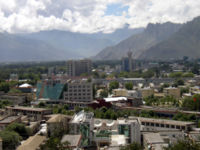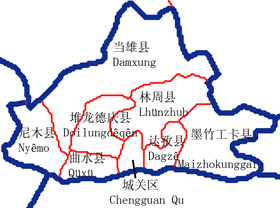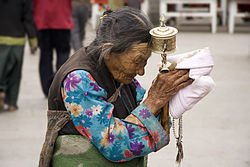
Lhasa
About this schools Wikipedia selection
This selection is made for schools by a children's charity read more. Child sponsorship helps children one by one http://www.sponsor-a-child.org.uk/.
| Lhasa Lasa |
|
|---|---|
| Tibetan transcription(s) | |
| • Tibetan | ལྷ་ས་ |
| • Wylie transliteration | lha sa |
| • pronunciation in IPA | [ʹl̥ʰásə] or [ʹl̥ʰɜ́ːsə] |
| • official transcription (PRC) | Lha sa |
| • THDL | Lhasa |
| • other transcriptions | |
| Chinese transcription(s) | |
| • Traditional | 拉薩 |
| • Simplified | 拉萨 |
| • Pinyin | Lāsà |
| Lhasa main street | |
|
|
|
| Coordinates: 29°39′N 91°07′E | |
| Country | China |
| Region | Tibet |
| Prefecture | Lhasa Prefecture |
| Government | |
| • Mayor | Doje Cezhug |
| Area | |
| • Land | 53 km2 (20 sq mi) |
| Elevation | 3,650 m (11,980 ft) |
| Population (2004 est.) | |
| • Total | 257,400 |
| • Major Nationalities | Han Chinese; Tibetan; Hui |
| • Regional dialect | Tibetan language, Hohhot dialect |
| Time zone | +8 |
| Area code(s) | 850000 |
Lhasa, (pronounced [ʹl̥ʰásə] or [ʹl̥ʰɜ́ːsə] in Tibetan, [l̥asa] in English) sometimes spelled Lasa, is the capital of Tibet and the administrative capital of the Tibet Autonomous Region of the People's Republic of China. Lhasa is located at the foot of Mount Gephel.
The city is the traditional seat of the Dalai Lama and the Potala and Norbulingka palaces (both are included in a World Heritage Site) and in Tibetan Buddhism is regarded as the holiest centre in Tibet.
The city is home to 257,400 as of the 2004 census estimate, and at an altitude of approximately 3,650 metres (11,975 feet), is the highest capital city in the world.
Lhasa literally means "place of the gods", although ancient Tibetan documents and inscriptions demonstrate that the place was called Rasa, which means "goat's place", until the early 7th century.
The city is part of a township-level prefecture, the Lhasa Prefecture consisting of 7 small counties: Lhünzhub County, Damxung County, Nyêmo County, Qüxü County, Doilungdêqên County, Dagzê County and Maizhokunggar County.
History
There is considerable debate over the geographical prominence of Lhasa in early Tibetan history.
By the mid 7th century, Songtsän Gampo became the leader of the Tibetan Empire that had risen to power in the Yarlung River Valley. In 641 A.D., Songtsän Gampo, who by this time had conquered the whole Tibetan region, wedded Princess Bhrikuti of Nepal and Princess Wen Cheng of the Imperial Tang court. Through these marriages, he converted to Buddhism and proceeded to build the Ramoche and Jokhang temples in Lhasa to house two Buddha statues brought to his court by the two princesses, even as it was noted that Songtsän Gampo's empire was nomadic and he held court in large movable resplendent tents.
From the fall of the monarchy to the accession of the fifth Dalai Lama, the centre of political power in the Tibetan region was not situated in Lhasa. However, the importance of Lhasa as a religious site became increasingly significant as the centuries progressed. It was known as the centre of Tibet where Padmasambhava magically pinned down the earth demonness with the foundation of the Jokhang Temple built over her heart.
By the 15th century, the city of Lhasa had risen to prominence following the founding of three large Gelugpa monasteries by Je Tsongkhapa and his disciples in the 15th century. The three monasteries are Ganden, Sera, and Drepung monasteries which were built as part of the puritanical Buddhist revival in Tibet. The scholarly achievements and political knowhow of this sect eventually pushed Lhasa once more to centre stage.
The fifth Dalai Lama, Lobsang Gyatso ( 1617– 1682), conquered Tibet and moved the centre of his administration to Lhasa, as the religious and political capital of Tibet. In 1645 the Potala Palace began reconstruction on Red Hill. In 1648, the Potrang Karpo ( White Palace) of the Potala was completed, and the Potala was used as a winter palace by the Dalai Lama from that time. The Potrang Marpo ( Red Palace) was added between 1690 and 1694. The name Potala is possibly derived from Mount Potalaka, the mythological abode of Bodhisattva Avalokiteśvara. The Jokhang Temple was also greatly expanded around this time. Although some wooden carvings and lintels of the Jokhang Temple date to the 7th century, the oldest of Lhasa's extant buildings, such as amidst the Potala Palace, the Jokhang and some of the monasteries and properties in the Old Quarter date to this second flowering in Lhasa's history.
The 11th edition of Encyclopedia Britannica published between 1910-1911 noted the total population of Lhasa, including the lamas in the city and vicinity is about 30,000; a census in 1854 made the figure 42,000, but it is known to have greatly decreased since. Britannica noted that within Lhasa, there were about a total of 1,500 resident Tibetan laymen and about 5,500 Tibetan women. The permanent population also includes Chinese families (about 2,000). The city's residence also includes people from Nepal and Ladak (about 800), and a few from Bhotan and Mongolia and other places. The Britannica noted with interest that the Chinese have a crowded burial-ground at Lhasa, tended carefully after their manner and the Nepalese supply the mechanics and metal-workers.
In the first half of the 20th century, several Western explorers made celebrated journeys to the city, including Francis Younghusband, Alexandra David-Néel, and Heinrich Harrer. Lhasa was the centre of Tibetan Buddhism, and nearly half of its population were monks. The population of Lhasa was estimated at 25,000 in 1951, excluding some 15,000 monks in the area's monasteries, although with the invasion of China many people fled from the city including the living 14th Dalai Lama who fled from his residence in the Potala Palace into exile in India in 1959 after the Lhasa uprising.
Lhasa between 1987-1989 had major demonstrations against the Chinese occupation led by monks and nuns. As a result the Chinese government made life for monks and nuns more difficult by imposing restrictions and political re-educations in the monasteries. Many had to go through these "re-education sessions to align themselves with the Communist views and denounce the Dalai Lama and Tibetan independence." Many monks who refused were sent to prison, while others left the monasteries and many escaped into India to carry on with their studies.
As of the early 2000s, the city's population stands at about 255,000. For the history of Tibet since 1950, see the history of Tibet.
Dalai Lamas of Lhasa
Geography and climate
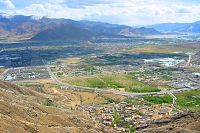
Lhasa 29°39.29′N 91°7.1′E and the prefecture covers an area of close to 30,000 km². It has a central area of 544 km² and a total population of 500,000; 250,000 of its people live in the urban area. Lhasa is home to the Tibetan, Han, and Hui peoples, as well as many other ethnic groups, but the Tibetan ethnic group makes up 87% of the total population.
Located at the bottom of a small basin surrounded by mountains, Lhasa has an elevation of 3,650 metres (12,000 feet) and lies in the centre of the Tibetan Plateau. The mountains around it rise to 5,500 metres (18,000 feet). The Kyi (or Kyi Chu) River, a tributary of the Yarlung Zangbo River), runs through the city. The city stands by the Lhasa River known to local Tibetans as the "merry blue waves,". It runs through the snow-covered peaks and gullies of the Nyainqentanglha mountains, extending 315 km. The river empties into the Yarlung Zangbo River at Qüxü, forming an area of great scenic beauty.
With its flat land and mild weather, Lhasa is free of both freezing winters and unbearably hot summers, having an annual average daily temperature of 8 degrees C (43 degrees F). It enjoys 3,000 hours of sunlight annually, so much more than most other cities, it is sometimes called the "sunlit city."
Lhasa has an annual precipitation of 500 mm. It rains mainly in July, August and September. The rainy seasons in the summer and autumn are widely regarded the "best" seasons of the year, when it rains mostly at night, and is sunny in the daytime.
- Temperature - Daily average (January) -1.2oC, 29.8oF; (July) 16.4oC, 61.5oF
- Precipitation - Daily average (January) 0.5 mm, 0.02 inches; (July) 129.7 mm, 5.11 inches.
Depending on how the status of Tibet before 1950 is interpreted, Lhasa can be regarded as the highest national capital at that time, surpassing La Paz, Bolivia, which currently holds that distinction.
| Climate data for Lhasa | |||||||||||||
|---|---|---|---|---|---|---|---|---|---|---|---|---|---|
| Month | Jan | Feb | Mar | Apr | May | Jun | Jul | Aug | Sep | Oct | Nov | Dec | Year |
| Source: | |||||||||||||
Administration
Administratively speaking, Lhasa is a prefecture-level city that consists of one district and seven counties. The district comprises the urban area of Lhasa and is called Chengguan District (Tibetan: ཁྲིན་ཀོན་ཆུས་, Wylie: khrin kon chus, simplified Chinese: 城关区; traditional Chinese: 城關區; pinyin: Chéngguān Qū). The seven counties are Lhünzhub, Damxung, Nyêmo, Qüxü, Doilungdêqên, Dagzê, and Maizhokunggar.
Economy
Competitive industry together with feature economy, are playing key roles in the next stage of Lhasa's rapid development. In view of maintaining the balance between humans and nature, tourism and service industry are emphasised by local governors as two growth engines for the future.
Agriculture and husbandry in Lhasa is at a high standard. Mainly, people plant highland barley and winter wheat in Lhasa. The resources of water conservancy, geothermal heating, solar energy, and various mines are abundant.
There is widespread electricity, and use of both machinery and traditional methods in the production of textiles, leathers, plastics, matches, embroidery, etc.. The production of national handicrafts has made great progress recently and the Tibetan rugs manufactured at the Lhasa Carpet Factory sell well.
At the same time, sunset industries which cause serious pollution will fade out, in hopes of building a healthy eco system. Environmental problems such as soil erosion, acidification, and loss of vegetation are being addressed on the local government agenda.
The tourism industry now brings significant business to the region, building on the attractiveness of the Potala Palace, the spectacular Himalayan landscape, and the many wild plants and animals native to the high altitudes of Central Asia. Many of Lhasa's rural residents practice traditional agriculture and animal husbandry. Lhasa is also the traditional and current hub of the Tibetan trading network. For many years, chemical and car making plants operated in the area, because the city's remoteness allowed them to pollute with minimal restriction. However, this has changed in recent years. Copper, lead, and zinc are mined nearby, and the Chinese government is experimenting with new methods of mineral mining and geothermal heat extraction in the area.
Demographics
Tibetan exile groups assert that ethnic Tibetans are now in a minority in Lhasa, because of the influx of migrants from other parts of the PRC over the past number of years (particularly Han and Hui Chinese). This is backed up by many foreign journalists who have reported from the city . Officially, the total population of Lhasa Prefecture-level City is 521,500 (including known migrant population, excluding military garrisons). Of this, 257,400 are in the urban area (including migrant population of 100,700), while 264,100 are outside. Nearly half of Lhasa Prefecture-level City's population lives in Chengguan District, which is the administrative division that contains the urban area of Lhasa (i.e. the actual city).
According to the 2000 census (which did not count the substantial People's Liberation Army garrison or the many undocumented migrants), the ethnic distribution in Lhasa Prefecture-level City was as follows in November 2000:
| Major ethnic groups in Lhasa Prefecture-level City by district or county, 2000 census | |||||||
|---|---|---|---|---|---|---|---|
| Total | Tibetans | Han Chinese | others | ||||
| Lhasa Prefecture-level City | 474,499 | 387,124 | 81.6% | 80,584 | 17.0% | 6,791 | 1.4% |
| Chengguan District | 223,001 | 140,387 | 63.0% | 76,581 | 34.3% | 6,033 | 2.7% |
| Lhünzhub County | 50,895 | 50,335 | 98.9% | 419 | 0.8% | 141 | 0.3% |
| Damxung County | 39,169 | 38,689 | 98.8% | 347 | 0.9% | 133 | 0.3% |
| Nyêmo County | 27,375 | 27,138 | 99.1% | 191 | 0.7% | 46 | 0.2% |
| Qüxü County | 29,690 | 28,891 | 97.3% | 746 | 2.5% | 53 | 0.2% |
| Doilungdêqên County | 40,543 | 38,455 | 94.8% | 1,868 | 4.6% | 220 | 0.5% |
| Dagzê County | 24,906 | 24,662 | 99.0% | 212 | 0.9% | 32 | 0.1% |
| Maizhokunggar County | 38,920 | 38,567 | 99.1% | 220 | 0.6% | 133 | 0.3% |
The Tibetan government in exile and reputable Western newspapers assert that, if the excluded PLA garrisons and migrants from outside Tibet are considered, ethnic Tibetans are now the minority in Lhasa. Resentment at the relative wealth and influence of the newcomers was one of the reasons behind the recent unrest in the city.
Culture and landmarks
Lhasa has many sites of historic interest, including the Potala Palace, Jokhang Temple, Sera Monastery, Zhefeng Temple, Drepung Monastery and Norbulingka. However, many important sites were damaged or destroyed mostly, but not solely, during the Cultural Revolution.
The city of Lhasa contains three concentric paths used by pilgrims to circumambulate (walk around) the sacred Johkhang Temple, many of whom make full or partial prostrations along these routes in order to gain spiritual merit. The innermost, the Nangkor (Nang-skor), is contained within the Jokhang Temple, and surrounds the sanctuary of the Jowo Shakyamuni, the most sacred statue in Tibetan Buddhism. The middle circumambulatory, the Barkor (Bar-skor), passes through the Old Town and surrounds the Jokhang Temple and various other buildings in its vicinity. The outer Lingkor (Gling-skor) encircles the entire traditional city of Lhasa. Due to the construction of a large new street, Beijing Lam, the Lingkor is not usually used by pilgrims today.
Every August the Shoton Festival is held in Lhasa, one of Tibet's biggest traditional festivals held since the 7th century.
Landmarks
- Potala Palace
- Barkhor
- Jokhang
- Norbulingka
- North Linkor Road
- Tibet University
- Lhasa Carpet Factory
- Lhasa Hotel
- Lhasa railway station
- Lhasa west railway station
- Central Beijing Road
Tourism
According to the region's authorities, 1.1 million people visited Tibet in 2004. Chinese authorities plan an ambitious growth of tourism in the region aiming at 10 million visitors by 2020; these visitors are expected to be mostly ethnic Chinese. Proponents of greater Tibetan autonomy are concerned that the increase in tourism will lead to an erosion of the indigenous culture of Tibet; in particular, these proponents have stated that renovation around historic sites, such as the Potala Palace, a UNESCO World Heritage Site, are creating a jarring " Disney-like" degradation of the sacred site.
Transport
Journalists report that the opening of the Railway—the highest plateau railway in the world—in July 2006 has brought with it an increasing demand for property which has pushed prices up.
Five trains arrive at and depart from Lhasa railway station each day. Train numbered T27 takes 47 hours, 28 minutes from Beijing West, arrives in Lhasa at 20:58 every day. The ticket costs 389 yuan for 'hard seat', or 813 yuan for a lower 'hard sleeper', 1262 yuan for a lower 'soft sleeper'. T28 from Lhasa to Beijing West departs at 08:00 and arrives in Beijing at 08:00 on the third day, taking 48 hours. There are also trains from Chengdu, Chongqing, Lanzhou, Xining, Guangzhou, and Shanghai. Initially the large altitude difference has caused problems on this route, giving passengers altitude sickness. To counter this, extra oxygen is pumped in through the ventilation system, and personal oxygen masks are available.
Lhasa Gonggar Airport is located about 98 kilometres south of the city. There is also a carpet factory there known for its high quality carpets, and the flagship hotel, the Lhasa Hotel has grown up in recent years.
Lhasa in entertainment
Life in Lhasa was covered by Austrian mountaineer Heinrich Harrer in his book Seven Years In Tibet and the film of that same name which starred Brad Pitt and David Thewlis. The book in particular relates the story of his life in Lhasa during the 1940s. His autobiography, Beyond Seven Years in Tibet, published in English in 2007 also gives a perspective on his time in Lhasa.
There are no pubs in Lhasa. There are some night spots which feature cabaret acts in which performers will sing English, Chinese, Tibetan, and Nepalese songs and dancers wear traditional Tibetan costume with long flowing cloth extending from their arms. As well, there are a number of small bars with live music, although they typically have limited drink menus and cater mostly to foreign patrons.
In 1995 a British electronic music act Banco de Gaia released the album Last Train to Lhasa. The Chinese rock artist Zheng Jun has recorded a hit song titled "Back to Lhasa" (Hui Dao Lasa). The song is filled with swirling Tibetan influences and rapidly took on the status of a classic. Lhasa is also referenced in " Terranigma", a RPG videogame that was released for the Super Nintendo in 1995.

